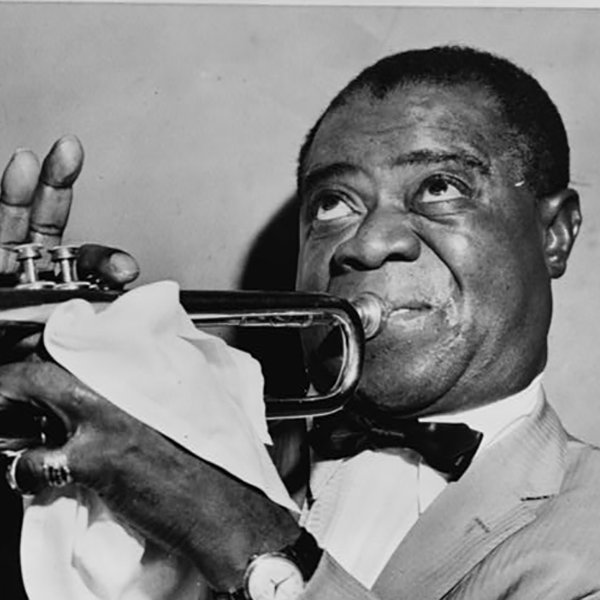
20 Apr Louis Armstrong Visits Africa
An excerpt from Smoke Signals: A Social History of Marijuana – Medical, Recreational & Scientific by Martin A. Lee.
In the opening pages of Ralph Ellison’s Invisible Man, the nameless narrator lights a reefer and listens to a recording of Louis Armstrong singing, “What did I do to be so black and blue,” a soulful lament that epitomized the plight of African Americans. Armstrong’s voice of musk and cinnamon imbues the lyrics with poignant emotion. Ellison’s protagonist, absorbing the smoke and sound, is propelled into an eerie reverie, a surreal space, the American Dream in blacklight. To be invisible was not just to lack acknowledgment other than scorn from the pale man; it was the fundamental condition of black people in white America.
“Black and Blue” was the centerpiece of Armstrong’s performance at an outdoor concert in Accra, Ghana, in 1956. More than 100,000 people thronged the city stadium on a sweltering afternoon to hear Satchmo sing this song with such intensity that it brought tears to the eyes of Kwame Nkrumah, Ghana’s prime minister, a moment captured on film.
Louis Armstrong, the most visible of invisible men, traveled the world over, but this trip to the Gold Coast of West Africa was special. When he saw the women of Ghana, he recognized the face of his own mother. “I know it now. I came from here, way back. At least my people did,” Armstrong asserted. “Now I know this is my country, too.”

The prodigal son, the grandchild of a slave, had returned to his ancestral homeland, a land where the ceremonial use of roots and herbs had long been linked to animist spiritual beliefs. A staple of African shamanism, cannabis and other consciousness-altering flora were revered as “sacred plants” that provided access to hidden knowledge and curative powers.
Pollen samples indicate the presence of cannabis in sub-Saharan Africa for at least two millennia. Introduced by overland traders from the Arab Middle East and later by Portuguese seamen traveling from India, the herb quickly spread throughout the continent.
Black Africans employed a variety of devices — clay pipes, gourds, bamboo stalks, coconut bowls — for inhaling “dagga,” as marijuana was called by several tribes, who regarded it as a “plant of insight.” According to the Tsongas of southern Africa, “Dagga deepens and makes men wiser.”
Earth-smoking, which entailed sucking cannabis fumes directly through a hole in a dirt mound, was an ancient tradition among Pygmies in the equatorial forest. The Zulus ingested psychoactive hemp via steam baths and enemas in addition to smoking it for pleasure; they also smoked it to boost their courage before going into battle. A Bantu tribe in the Congo dispensed cannabis as a means of punishment — miscreants were compelled to smoke a large quantity of marijuana until they either confessed to a crime or keeled over.
The Bashilenge in the Congo called themselves “Ben-Riamba” (“the sons of hemp”) and they greeted one another with the expression “mojo,” meaning both “hemp” and “life.” They attributed magical powers to hemp, which was thought to protect against all kinds of evil.
Cannabis had a medicinal reputation in Africa that varied from region to region. Cultivated as a source of fiber as well as for its remarkable resin, the versatile herb served as a remedy for a wide range of ailments, including dysentery, malaria, diarrhea, typhus, and rheumatism. The Hottentots, who applied it as a salve for snakebites, deemed dagga more valuable than gold. Sotho women used marijuana to facilitate childbirth, and Sotho children were fed ground-up hempseed paste while weaning. In West Africa, from whence Armstrong’s ancestors hailed, cannabis was utilized as a treatment for asthma.
The roots of jazz and blues extend back through slavery to the collective rhythmic patterns of indigenous tribes in West Africa, where cannabis had thrived for centuries. Thrown upon bonfires, marijuana leaves and flowers augmented nocturnal healing rituals with drum circles, dancing, and singing that invoked the spirit of the ancestors and thanked them for imparting knowledge of this botanical wonder. It was only natch that Satch, the musical savant and dagga devotee, felt right at home as soon as he set foot on West African soil. “After all,” he explained, “my ancestors came from here, and I still have African blood in me.”
Photo credit: Library of Congress. Copyright, Project CBD. May not be reprinted without permission.


Sorry, the comment form is closed at this time.